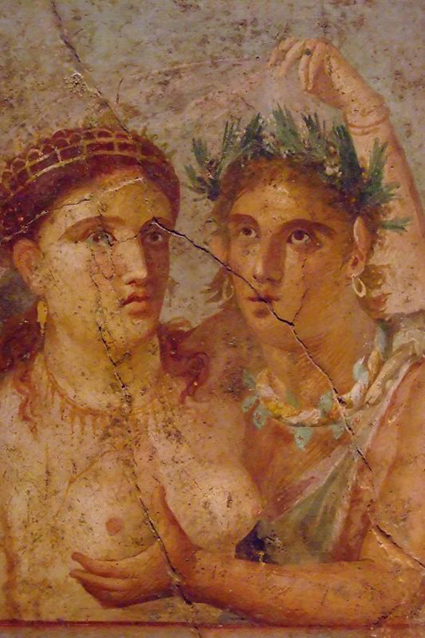Toward the end of March, the people of Tibet had a ceremony to expel the demons of bad luck from their homes, lives, and communities. The people of Bali, which is east of Java, also hold public expulsions of demons at least once a year, and on a new moon.
Each village sets food at the nearest crossroads and then goes to the local temple. Everyone prays and blows horns to summon the demons. Then people begin to bang on anything that will make a loud noise, thus frightening the entities which flee the area.
The demons can’t resist the food, pause at the crossroads, and are ambushed by a priest who curse them. This final ambush causes the evil demons to leave the area, and order is restored.
You can duplicate this ritual at home by leaving food on your front doorstep. The food is not going to come back into your home – so leave it on a paper plate instead of your good china.
Then go through the house, calling and whistling to summon the demons. You will want to sound very musical and inviting. Flutes and pan pipes were often used for this purpose.
When you have gone through every room of your home, and you feel that you have attracted the attention of every bad spirit in your home, suddenly begin banging on pots and pans making a loud noise. Have someone stationed at the door, and when the loud noise begins, have them open the door.
The noise will frighten them, but the bad luck entities of the house won’t be able to resist stopping for the food. Now, use this charm to send them packing:
Off with you spirits of fear, spirits of poverty, spirits of evil, spirits of anger, spirits of unhappiness, spirits of pain, spirits of death.
(You can add to this list and personalize it as much as you’d like.)
Repeat three times – each time louder and more commanding than the last.
Give way to the sun, and the moon,
For this is a sanctuary,
This is a place made safe.
Repeat three times – starting with a loud commanding voice and then diminishing in volume but increasing in determination.
Now, very dramatically and decisively, shut the door and lock it. Say:
Blessings and peace upon us,
Blessings and peace.
Repeat three times – smiling.
Very Important:
Do not bring the food you left on the doorstep back into the house, rather, take it away and leave it in a dumpster or put it by a crossroads not close to your home.
Note: This post was put together by Shirley Twofeathers for Gypsy Magic, and has been moved to my new website, here at shirleytwofeathers.com. You may repost and share without karmic repercussions only if you give me credit and a link back to this website. Blessed be.
- Themes: Air, Health
- Symbols: A Pot; Turquoise; Musk; a Star; Wind; Cow Images
- Presiding Goddess: Nut
About Nut:
This great Egyptian sky goddess bears a star spangled belly that stretches over the earth like a protective atmosphere. Today she breathes on us with a late March zephyr bearing health and well being.
Legend tells us that when Ra went to escape the earth, Nut offered her aid by becoming a huge cow who lifted him into heaven. When Nut found herself dizzy from the effort, four gods rushed to her aid. They later became the four pillars of creation – the four winds.
To Do Today:
If the weather permits, I highly recommend a brisk, refreshing walk. Breathe deeply of the air, which has rejuvenating healthy energies today. As you exhale, repeat the goddess’s name, Nut, and listen as she responds in the breeze.
Any type of wind magic honors Nut, and it is certainly fitting today. If the wind blows from the west, sprinkle water into it for emotional healing. If it blows from the east, toss a feather out so it can return to you with healthy outlooks. If it blows from the north, sift a little soil into the wind to give fruitful foundations to a generating idea, and if it blows from the south, burn musk incense to manifest vital energy and a little passion.
From: 365 Goddess
Note: I personally think that any day is a good day to go outside and smell the breeze. The simple wind magicks mentioned here are also effective at any time and in any place.
Today (March 26) marks the beginning of the plowing season in Slavic regions. Before this date the earth is regarded as pregnant. It is a crime against nature and Leshachikha to plow the soil with iron tools when it till bears a magical child (spring). Once earth has given birth, the fields can then accept new seed, which the birds will also appreciate!
From 365 Goddess, we have this way to celebrate the day:
- Themes: Earth; Nature; Harvest; Birth; Protection
- Symbols: Soil; a Leaf; Seeds
- Presiding Goddess: Leshachikha
About Leshachikha: A goddess who sometimes appears as a Slavic forest, a wild animal, or a leaf, Leshachikha is said to have died in October and revived around this time in spring. She fiercely protects her lands, not taking kindly to any who abuse them. In this manner she teaches us about reciprocity and nature’s fury. Additionally, Leshachikha’s watchful aspect can be applied to our figurative lands – for example, safeguarding our homes.
To Do Today:
Go to a nearby field or park today and scatter some seed to Leshachikha to greet her as she awakens.
Whenever you need a little extra protective energy, pick up a fallen leaf and put it in your pocket. This will keep Leshachikha’s guardian powers with you all day. To bring that protection into your home, wax the leaf to preserve it, symbolically sustaining the magical energy forever. Put the waxed leaf near your entryway or in the room where you spend the most time.
The month of March was the traditional start of the campaign season, and the Tubilustrium was a ceremony to make the army fit for war. It was held on March 23, the last day of the Greater Quinquatrus (the festival of Mars and Minerva), and it occurred again on May 23.
The sacred trumpets (tubae) were originally war trumpets, but later they were used for ceremonial occasions. It is not clear if the army was involved, or if it was merely a ceremony to purify the trumpets used in summoning the assembly on the following day.
The ceremony was held in Rome in a building called the Hall of the Shoemakers (atrium sutorium) and involved the sacrifice of a ewe lamb. Romans who did not attend the ceremony would be reminded of the occasion by seeing the Salii dancing through the streets of the city.
Found at: Wikipedia
The Quinquatrus (March 19 through March 23) was named for the fact that it was the fifth day after the Ides (by the Roman method of inclusive counting), but popularly it came to be regarded as a five-day holiday in honor of Mars.
It marked the start of the traditional campaign season for the army. The day also became a feast day for Minerva, despite any clear link between the two deities. (The reason probably was that Minerva’s temple on the Aventine was dedicated on that day.) It seems that women were accustomed to consult fortune-tellers and diviners upon this day.
This primary festival of Minerva was mainly celebrated by artisans but also by students. Minerva, was the virgin goddess of poetry, medicine, wisdom, commerce, weaving, crafts, the arts, dyeing, magic, science, and the inventor of music. She is often depicted with her sacred creature, an owl, which symbolizes her ties to wisdom. March 23, Day of Artisans, is specifically dedicated to her.
 As Minerva Medica she is the patroness of physicians. Minerva is believed to be the inventor of numbers and musical instruments. She is thought to be of Etruscan origin, as the goddess Menrva or Menerva. Later she was equated with the Greek Athena and as such is also sometimes associated as a Goddess of war.
As Minerva Medica she is the patroness of physicians. Minerva is believed to be the inventor of numbers and musical instruments. She is thought to be of Etruscan origin, as the goddess Menrva or Menerva. Later she was equated with the Greek Athena and as such is also sometimes associated as a Goddess of war.
She is the daughter of Jupiter. In the temple on the Capitoline Hill she was worshiped together with Jupiter and Juno, with whom she formed a powerful triad of gods. Another temple of her was located on the Aventine Hill. The church of Santa Maria Sopra Minerva is built on one of her temples.
Source: Pantheon.org
In Bali, the last day their 210 day Saka calendar marks the Balinese feast of purification. This is the time of the year when the lord of hell cleans out his underworld lair, and all manner of demons and evil spirits are left to roam Bali free.
During this time….when evil is afoot……the natives go to elaborate lengths to purify both their individual homes as well as the island. No corner or stone is left untouched as rites of purification and spells for protection are recounted
On this Saka New Year’s Eve, it is all blaring noise and merriment. Every Balinese household starts the evening with blessings at the family temple and continues with a ritual called the pengrupukan where each member participates in ‘chasing away’ malevolent forces, known as bhuta kala, from their compounds – hitting pots and pans or any other loud instruments along with a fiery bamboo torch.
These ‘spirits’ are later manifested as the ogoh–ogoh to be paraded in the streets. As the street parades ensue, bamboo cannons and occasional firecrackers fill the air with flames and smoke. The Nyepi Eve parade usually starts at around 19:00 local time.
This date varies from year to year, in 2019, it falls on March 6. It is based on the Saka calendar of western Indian origin, one among the many calendars assimilated by Indonesia’s diverse cultures. The Saka is 78 years behind the Gregorian calendar, and follows a lunar sequence.
If you’d like to honor this tradition, here is a simple house cleansing ritual:
You will need a broom, some sea water, or rain water with some sea salt dissolved in it, and an Asperger (optional). Open all the windows and doors in your house and starting from the center sweep the whole house. Move Deosil (clockwise) as much as possible. As you go, visualize all negativity as a wispy grey cloud which you are driving out through the windows and doors.
Now take your salt water (and Asperger if you have one) and sprinkle the salt water around the boundaries of your whole home, making sure that you include the sills of all the doors and windows. Be very careful not to make everything too wet, or to sprinkle any electrical equipment, switches or sockets, etc.
As you do each door or window say: “I mark this boundary that no negativity be allowed to enter here. Blessed be.” and then close it.
If the weather is really inclement you may need to work room by room rather than doing the whole house in one go. In this case make sure you cover the boundaries between rooms and any passageways, stairs, etc. without windows.
Note: This house cleansing ritual can be used at any time.
Whenever you move into a new home it is as well to cleanse it to remove any residual negative energies which may have been left behind by the previous occupants. You may also like to do this after any period of upset in your home to thoroughly drive out the problem, or if you have been visited by someone who seems to have left some of their negativity behind them.
Sources:
The Ides of March is the name of the 15th day of March in the Roman calendar.
The word Ides comes from the Latin word “idus“, a word that was used widely in the Roman calendar indicating the approximate day that was the middle of the month. The term ides was used for the 15th day of the months of March, May, July, and October, and the 13th day of the other months. The Ides of March was a festive day dedicated to the god Mars and a military parade was usually held.
In modern times, the term Ides of March is best known as the date on which Julius Caesar was assassinated in 44 B.C. Caesar was stabbed to death in the Roman Senate by a group of conspirators led by Marcus Junius Brutus and Gaius Cassius Longinus.
Another point which arises is Shakespeare’s use of the Ides of March and (the lack of doubt in) Marcus Brutus’ decision to assassinate Caesar to portray an atmosphere of madness, pleasure, and pandemonium. It is said that on ides of March the sea succumbs to chaos and the full moon brings high tides. All these points give the Ides of March a very mysterious quality.
The ides were originally meant to mark the full Moon (the “halfway point” of a lunar month), but because the Roman calendar months and actual lunar months were of different lengths, they quickly got out of step. The ancient Romans considered the day after the calends (first of the month), nones (ninth day before the ides, inclusive), or ides of any month as unfavorable. These were called dies atri.
According to Plutarch, a seer had foreseen that Caesar would be harmed not later than the Ides of March; and on his way to the Theatre of Pompey (where he would be assassinated), Caesar met the seer and joked, “The ides of March have come”, meaning to say that the prophecy had not been fulfilled, to which the seer replied “Aye, Caesar; but not gone.” This meeting is famously dramatized in William Shakespeare’s play Julius Caesar, when Caesar is warned by the soothsayer to “beware the Ides of March.” Furthermore, Suetonius writes that the haruspex Spurinna warns Caesar of his death which will come “not beyond the Ides of March” as he is crossing the river Rubicon.
In Canada, the Ides of March is celebrated with the drinking of Bloody Caesars.
Here’s a recipe:
- 6 oz. Clamato Juice
- 1–1½ oz. Vodka
- 2 Dashes hot sauce
- 4 Dashes Worcestershire sauce
- Celery salt
- Freshly ground pepper
- Lime wedge
- 1 Crisp celery stalk
Rim the glass (usually a high ball glass) with celery salt, and a lime wedge.
Found at Wikipedia
A Storm moon is, according to weather folklore, the moon which occurs in March during shifting weather patterns in the northern hemisphere.
This is the month when Spring finally arrives, around the time of the Equinox, and we see new life begin to spring forth. As the Wheel of the Year turns once more, heavy rains and gray skies abound — the earth is being showered with the life-giving water it needs to have a fertile and healthy growing season. This is also a time of equal parts light and darkness, and so a time of balance.
Correspondences:
- Colors: Green, yellow, light purple
- Gemstones: Bloodstone, aquamarine
- Trees: Dogwood, honeysuckle
- Gods: Isis, the Morrighan, Artemis, Cybele
- Herbs: High John, pennyroyal, wood betony, apple blossom
- Element: Water
Use this month for magical workings related to rebirth and regrowth. New life is blooming during this phase of the moon, as is prosperity and fertility.
More March moon lore:
As the temperature begins to warm and the ground begins to thaw, earthworm casts appear, heralding the return of the robins. The more northern Native American tribes knew this Moon as the Full Crow Moon, when the cawing of crows signaled the end of winter; or the Full Crust Moon, because the snow cover becomes crusted from thawing by day and freezing at night.
The Full Sap Moon, marking the time of tapping maple trees, is another variation. To the settlers, it was also known as the Lenten Moon, and was considered to be the last full Moon of winter.
It is also called seed moon, moon of winds, crow moon, moon of the snow-blind, and Full Worm Moon.
Source: Unknown
Throughout the year, the sun waxes and wanes. At the Winter Solstice, the shortest day of the year, the sun is only visible for a few short hours. Days become longer and at the Spring or Vernal Equinox, day and night are equal. At the Summer Solstice, the sun is visible for the longest period of time (the longest day of the year). Days start to become shorter and at the Autumnal Equinox, day and night are equal again. Finally, as the sun wanes, we are at the Winter Solstice again.
During a solar eclipse, we experience what might be called a “micro year”. The sun is whole, then partially or completely hidden, and then visible again. Within just a few minutes, an energy similar to a complete cycle of solstices and equinoxes can be felt.
In addition to this somewhat seasonal energy, we are aware of the Moon’s presence. Her shadow falls across the Earth as she appears between the Earth and the Sun. This adds the unification of solar and lunar energy, reinforcing the sense of wholeness, completion and cycles of a solar eclipse.
Consider this fact about solar eclipses: A solar eclipse can only occur during the day, on a new moon. This means that you are working with new moon energy (great for getting rid of things and letting go).
A solar eclipse does not have to be visible for you to work magic. You won’t be able to see every eclipse unless you can travel all over the world easily! Simply look at charts and almanacs to find the exact time of the eclipse, and work your magic then.
Solar eclipses are perfect for some specific types of magick. Consider the solar eclipse of June 10/11, 2002. Because this eclipse was close to the Solstice, the energy of the Solstice dominated the beginning of the eclipse.
In the Northern Hemisphere of the world, the sun is waxing as we near the Summer Solstice (In the Southern Hemisphere, the sun is waning and the Winter Solstice is approaching.)
When an equinox occurs at the time of the waning year (from the Summer Solstice to Yule) it is a good time to rid yourself of unwanted energies, bad habits, unhealthy patterns of thinking and acting, negativity, and other baneful things in your life. You can work with both the new moon energy, and the waning year energy, in addition to the energy of the eclipse.
Here’s an example:
Your ex-lover caused you a lot of pain. Whenever your new love gets close to you, you push away to prevent getting hurt again. You realize that you cannot fully love this new person until you let your guard down. About a half hour before the eclipse begins, you work to let go of the old pattern of pushing away. As the eclipse begins, you feel the pattern dissolving. As the eclipse is ending, you reinforce the growth between you and your new love, and the growing trust within you. This waning/waxing type of magic works well with eclipses.
Consider the time of year the solar eclipse will occur during. Is the sun waxing or waning? Next, consider the lunar influence, the moon is new and will be waxing in a day or two. Finally, consider the waning/waxing energy of the solar eclipse. Use this information to develop your own, tailor-made spells, rituals and rites.
Another interpretation:
A Solar Eclipse occurs in nature as a phenomenon when the Moon enters between the Sun and the Earth therefore blocking (or better thinking as filtrating) the light of the Sun. In astrology a Solar Eclipse is a very powerful New Moon, while every month has a new Moon, a solar eclipse occurs approximately every six months.
A Solar Eclipse can be seen as a very powerful New Moon where important beginnings or endings occur, it is the perfect time to work magic in your life especially related with previous thoughts and ideas that were holding you back.
You can imagine how a solar eclipse works by imagining the following narrative:
Imagine yourself as a caterpillar that has willingly entered in its cocoon of contemplation. You remember your old self, the thoughts you made and the actions that these thoughts have led you to take. You have all the ideas about yourself who you want to be and what you want to do with your future. All these ideas and thoughts-the past, present and future- coexist during this stage.
The solar eclipse will give you the power when you are ready to break this cocoon and will give you the boost to completely transform into a new form, the butterfly. Hence, the Solar Eclipse is the perfect timing for a Metamorphosis, transcendence to a new state of being. Cutting down all the restraints that were bounding you to the ground and give you the breeze to flip your wings and fly and explore the world with a new set of wise eyes.
A Solar eclipse is often described in alchemic and occult texts as the Alchemical Wedding where the Sun marries the Moon, a perfect balance.
Alternatively:
The solar eclipse is the symbol of the Dark Lord, also called the Lord of Shadows, the Leader of the Wild Hunt, Hades, Pluto and the death and resurrection aspects of Cernunnos, Dionysus — and, on a cosmic level, Shiva, among others. The Christian comparison is the portion of the crucifixion of Jesus when he descends into hell then resurrects. As such, the solar eclipse (the Bible story of the crucifixion states the sun darkened at 9.00 am) is a time for ritual observances that link the practitioner with the death passage portion of the cycle of life.
This is an opportunity to connect with the Shadowlands or the Underworld and to face one’s own fears and uncertainties about death. By confronting death through meditation, the face of Death is unmasked. The face one sees may initially be grotesque and horrible, but once the beholder accepts that this is also the face of the giver of life’s energy, that face changes and is beautiful to behold. This is the significance of focusing on the passage. By facing our fears, we gain insight and freedom — death is no longer to be feared.
Once a person is no longer fearful of death or the Underworld, the solar eclipse becomes a good time to honor ancestors, visit with the spirits of the departed, charge Craft tools of dark power magics and honor the Dark Powers.
The eclipse does not last long, so lengthy ceremonies would not be in order unless you create one that begins prior to the eclipse and encompasses the eclipse. Instead, if you are feeling connected, you may simply want to light some incense and a candle and invite some departed to visit with you for just a little while so you can ask for guidance, tell the person you love him/her, offer forgiveness or ask for it as the case may be, or use the time to celebrate your union with the Crone and the Dark Lord. It is also a good time to end anger and hostility, so that when the Sun reappears the Light will shine within you as well upon the Earth.
Sources:
- Green Witchcraft
- Ancient Magical Recipes Online
- Angel at Care2Share
Valentine’s Day has its roots in ancient orgiastic festivals. On February 14, The Romans celebrated Febris (meaning fever), a sacred sexual frenzy in honor of Juno Februa, an aspect of the goddess of amorous love. This sex fest coincided with the time when the birds in Italy were thought to mate.
The ecstatic rites of the Goddess merged over time with those of Lupercalia, the bawdy festivities in honor of the pagan god of sex, drugs and rock-n-roll, Pan, which were observed on the following day, February 15.
On Lupercalia, (named, incidentally, in honor of the she-wolf who suckled Romulus and Remus), men and women inscribed their names on love notes or billets and then drew lots to determine who their sex partner would be during this anything goes festival of erotic games.
Sulpicia, a first century BC Roman poet, describes her participation in the events with hearty candor:
“At last love has come. I would be more ashamed
to hide it in cloth than leave it naked.
I prayed to the Muse and won. Venus dropped him
in my arms, doing for me what she
had promised. Let my joy be told, let those
who have none tell it in a story.
Personally, I would never send off words
in sealed tablets for none to read.
I delight in sinning and hate to compose a mask
for gossip. We met. We are both worthy.”
Roman armies took their Lupercalia customs with them as they invaded France and Britain. One of these was the above mentioned lottery where the names of available maidens were placed in a box and drawn out by the young men. Each man accepted the girl whose name he drew as his love – for the duration of the festival, or sometimes longer.
Lupercalia, with its lover lottery, had no place in the new Christian order. In the year 496 AD, Pope Gelasius did away with the festival of Lupercalia, citing that it was pagan and immoral. He chose Valentine as the patron saint of lovers, who would be honored at the new festival on the fourteenth of every February. The church decided to come up with its own lottery and so the feast of St. Valentine featured a lottery of Saints. One would pull the name of a saint out of a box, and for the following year, study and attempt to emulate that saint.
The Feast of St. Valentine and the saint lottery lasted for a couple hundred years, but the church just couldn’t rid the people’s memory of Lupercalia. In time, the church gave up on Valentine all together. The lottery finally returned to coupling eligible singles in the 15th century. The church attempted to revive the saint lottery once again in the 16th century, but it never caught on.
During the medieval days of chivalry, the single’s lottery was very popular. The names of English maidens and bachelors were put into a box and drawn out in pairs. The couple exchanged gifts and the girl became the man’s valentine for a year. He wore her name on his sleeve and it was his bounded duty to attend and protect her. The ancient custom of drawing names on the 14th of February was considered a good omen for love.
By the early 1600s, handmade valentines were customarily sent from admirers to sweethearts. About 1800 the first commercial cards appeared. Cards were usually sent anonymously. As early as 1822, an English official reported having to hire extra postal workers on this day. In 1849, Esther Howland of Worcester, Massachusetts, started selling quality valentines so popular that she was called “Mother of the American Valentine.”
Sources:
















